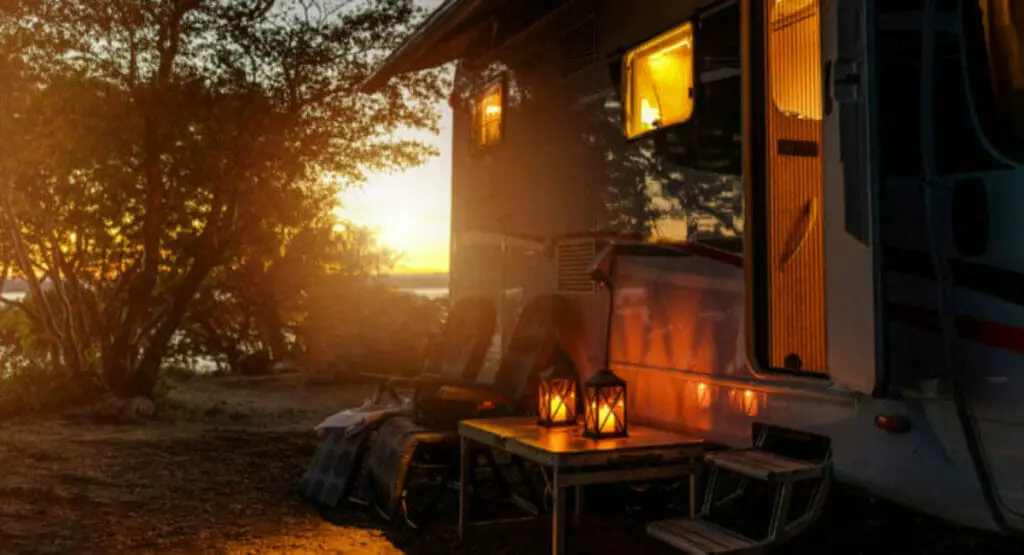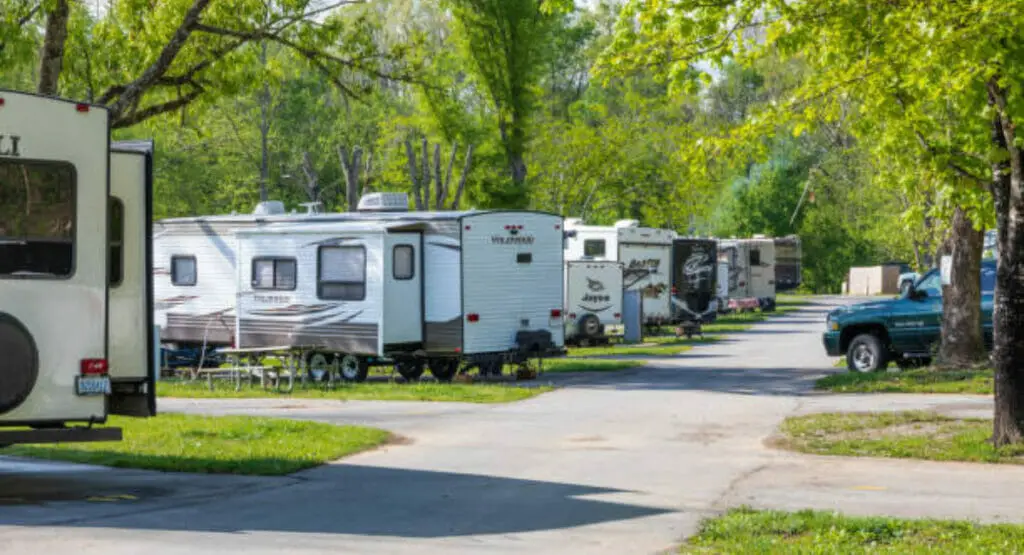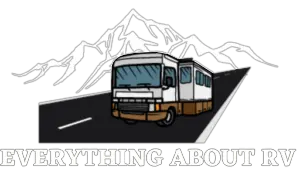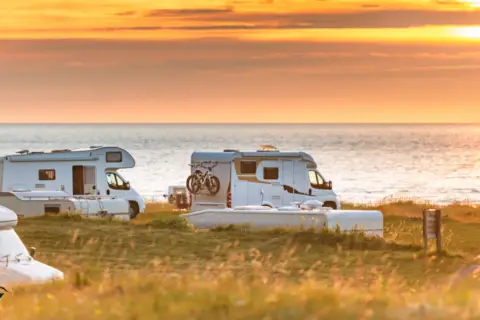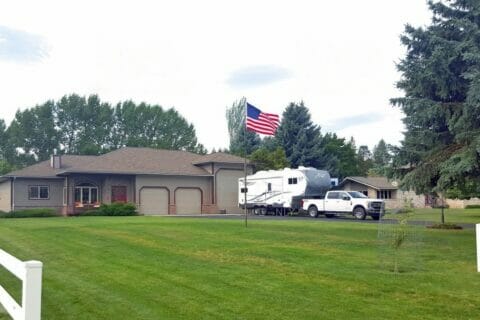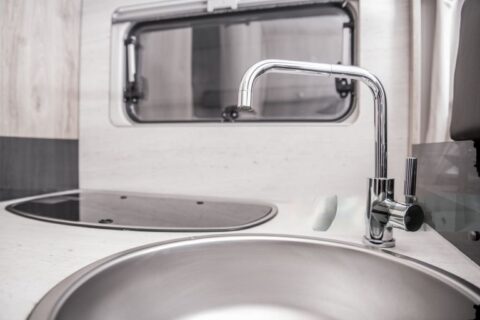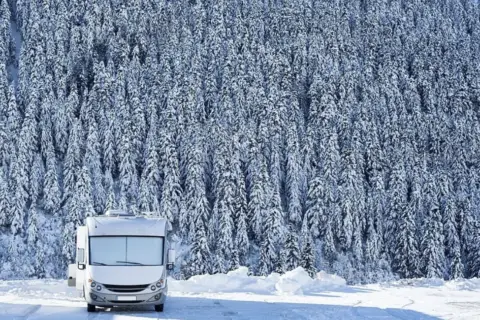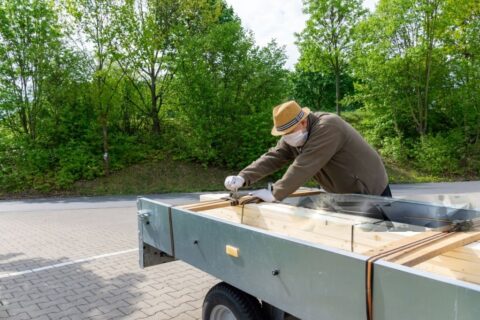An RV winterizing kit is necessary in order to protect the water systems of your RV from damage caused by freezing temperatures. It includes items such as a valve and siphon hose, adapters to attach to your water pump, a water heater bypass kit, a “blowout plug” or adapters to connect to an air compressor, and a hand pump. These items help to drain the water lines and tanks and add non-toxic antifreeze to the water system.
A winterizing kit for an RV is a set of supplies and tools that are used to prepare the RV for winter storage or use in cold weather. A winterizing kit may contain a variety of specific items, but some common ones might be:
1. Antifreeze:
This is used to protect the water lines and tanks in the RV from freezing.
Antifreeze is an important part of an RV winterizing kit because it helps prevent the water lines and tanks in the RV from freezing during cold weather. When water freezes, it expands, which can cause damage to the pipes and tanks in an RV. If the pipes in an RV freeze and burst, it can lead to costly repairs and potentially render the RV unusable until those repairs are made.
Using antifreeze in an RV helps to prevent this type of damage by lowering the freezing point of the water in the RV’s pipes and tanks. When the temperature outside drops below the freezing point of the water in the RV, the antifreeze will prevent the water from freezing. This is especially important for RVs that may be stored outside or in unheated storage areas during the winter months.
In addition to protecting the water lines and tanks from freezing, antifreeze can also help prevent corrosion in the pipes and tanks. It does this by acting as a lubricant and helping to prevent the formation of scale and sediment.
Overall, using antifreeze is an important part of winterizing an RV and can help protect the RV’s plumbing system from damage caused by freezing temperatures.
2. Insulating covers:
These can be used to keep heat in and cold out by covering windows, doors, and vents.
Insulating covers are an important part of an RV winterizing kit because they help keep the interior of the RV warm and protect it from the cold temperatures outside. There is a variety of insulating covers that can be used on an RV, including covers for windows, doors, and vents.
Insulating covers for windows and doors can help reduce draughts and keep the heat inside the RV. This can help reduce the amount of energy needed to heat the RV, which can save on fuel costs and extend the life of the RV’s heating system. Insulating covers for vents can help prevent air from entering the RV and can also help reduce condensation and moisture build-up inside the RV.
In addition to keeping the interior of the RV warm, insulating covers can also help protect the RV’s exterior from harsh weather conditions. For example, covers for windows and doors can help to protect the RV’s paint and sealant from fading or cracking due to exposure to the sun, wind, and other elements.
Overall, using insulating covers is an important part of winterizing an RV and can help to keep it warm, reduce energy costs, and protect it from damage caused by harsh weather conditions.
3. Heating pads or blankets:
These can be used to keep tanks and pipes from freezing or to provide additional warmth in the living areas of the RV.
Heating pads or blankets are an important part of an RV winterizing kit because they can be used to help keep the tanks and pipes in the RV from freezing during cold weather. These devices work by providing a source of heat that helps to raise the temperature of the tanks and pipes, preventing the water inside from freezing.
Heating pads or blankets can also be used to provide additional warmth in the living areas of the RV. This can be especially useful if the RV is being used in cold weather and the primary heating system is not sufficient to keep the interior warm.
In addition to providing warmth, heating pads or blankets can also help prevent condensation and moisture build-up inside the RV. This can help prevent the formation of mold and mildew, which can cause damage to the RV’s interior and create unhealthy living conditions.
Overall, using heating pads or blankets is an important part of winterizing an RV and can help keep the RV’s tanks and pipes from freezing, provide additional warmth, and prevent condensation and moisture build-up.
4. Skirting:
A skirting kit can be used to create a barrier around the bottom of the RV to help keep out drafts and cold air.
Skirting is an important part of an RV winterizing kit because it helps to create a barrier around the bottom of the RV that can help keep out drafts and cold air. Skirting can be made from a variety of materials, including plastic, vinyl, or fabric, and is typically attached to the RV using clips, snaps, or Velcro.
One of the main benefits of skirting an RV is that it can help keep the interior warm during cold weather. By blocking drafts and cold air from entering the RV, skirting can help reduce the amount of energy needed to heat it and save on fuel costs. Skirting can also help extend the life of the RV’s heating system by reducing the workload on the system.
In addition to providing warmth, skirting can also help protect the RV’s exterior from harsh weather conditions. For example, skirting can help prevent damage to the RV’s paint and sealant from exposure to the sun, wind, and other elements. Skirting can also help to reduce the risk of damage from rocks, debris, and other objects that may be kicked up by the tires while the RV is in motion.
Overall, using skirting is an important part of winterizing an RV and can help to keep it warm, reduce energy costs, and protect the RV’s exterior from damage caused by harsh weather conditions.
5. Dehumidifier:
A dehumidifier can help prevent condensation and mold growth inside the RV during the winter months.
A dehumidifier is an important part of an RV winterizing kit because it helps prevent condensation and moisture build-up inside the RV. When the air inside an RV becomes too humid, it can lead to the formation of condensation on the windows, walls, and other surfaces. This can create an ideal environment for mold and mildew to grow, which can cause damage to the RV’s interior and create unhealthy living conditions.
A dehumidifier works by removing excess moisture from the air inside the RV. This can help to reduce the risk of condensation and moisture buildup, which can in turn help to prevent the formation of mold and mildew.
In addition to preventing moisture buildup, a dehumidifier can also help improve the overall air quality inside the RV. By removing excess moisture from the air, a dehumidifier can help reduce the risk of respiratory problems and allergies caused by mold and mildew.
Depending on the specific needs of your RV, you may also want to include other items in your winterizing kits, such as
Overall, using a dehumidifier is an important part of winterizing an RV and can help to prevent condensation and moisture build-up, improve air quality, and reduce the risk of mold and mildew growth.
1. Generator
A generator is not necessarily a required part of an RV winterizing kit, but it can be a useful tool to have on hand for certain situations. For example, a generator can be used to provide power to the RV in the event of a power outage or if the RV is being used in an area without access to electricity.
During the winter months, a generator can be especially useful for providing heat and electricity to an RV that is being stored outside or in an unheated storage area. If the RV’s primary heating system is not sufficient to keep the interior warm, a generator can be used to provide additional heat. A generator can also be used to power lights, appliances, and other electronics in the RV.
In addition to providing heat and power, a generator can also be useful for running a dehumidifier or other devices that may be needed to help prevent moisture buildup and protect the RV from damage during the winter months.
Overall, while a generator is not a required part of an RV winterizing kit, it can be a useful tool to have on hand in certain situations and can help provide heat, power, and protection for the RV during the winter months.
2. Additional blankets
Additional blankets are a useful item to have in an RV winterizing kit because they can provide additional warmth and insulation in the living areas of the RV. This can be especially useful if the RV’s primary heating system is not sufficient to keep the interior warm during cold weather.
Blankets can be used in a variety of ways to help keep the RV warm, including covering windows and doors to help reduce drafts, covering the floor to add insulation, or draping over furniture to add an extra layer of warmth. In addition to providing warmth, blankets can also be used for comfort and as an extra layer of protection against the cold.
It is also a good idea to have a variety of blankets in an RV winterizing kit, including heavier blankets for added warmth and lighter blankets that can be used as a layer of insulation. This can help ensure that you have the right type of blanket for different weather conditions and needs.
Overall, having additional blankets in an RV winterizing kit is a simple but effective way to help keep the RV warm and comfortable during cold weather.
3. Warm clothing
Warm clothing is an important item to have in an RV winterizing kit because it can help keep you warm and comfortable during cold weather. This is especially important if the RV’s primary heating system is not sufficient to keep the interior warm or if you will be spending a significant amount of time outside of the RV in cold weather.
Having warm clothing in an RV winterizing kit can include items such as coats, hats, gloves, scarves, and boots. It is a good idea to have a variety of warm clothing items in the kit so that you can dress appropriately for different weather conditions and activities.
In addition to keeping you warm, warm clothing can also help protect you from other hazards that can be present in cold weather. For example, hats, gloves, and scarves can help to protect your face, hands, and neck from wind and cold, which can help to prevent frostbite and other cold-related injuries.
Overall, having warm clothing in an RV winterizing kit is an essential part of preparing for cold weather and can help keep you warm, comfortable, and safe during your travels.
4. A portable heater
A portable heater is a useful addition to an RV winterizing kit because it can add more heat to the RV’s living spaces. This can be especially helpful if the RV’s main heating system is not powerful enough to maintain a comfortable interior temperature in cold weather.
A portable heater can be used to supplement the RV’s primary heating system or as a backup heat source in the event that the primary system fails. Portable heaters come in a variety of sizes and types, including electric, propane, and kerosene heaters, so you can choose the type that best meets your needs.
In addition to providing warmth, a portable heater can also be useful for de-icing the RV’s windows and doors or for thawing frozen pipes and tanks.
Overall, having a portable heater in an RV winterizing kit can be a useful tool for providing additional heat and warmth in the RV during cold weather.
5. Fuel stabilizer to help prevent fuel from gelling in cold temperatures.
A fuel stabilizer is important to add to the RV winterizing kit as it prevents the gasoline from separating into different layers of ethanol and alcohol, which can lead to engine deterioration. Additionally, the fuel stabilizer prevents the gasoline from evaporating, which helps prevent the sticky resins that damage and ruin the carburetor and fuel system.
Conclusion
Let me tell you, my friend, using an RV winterizing kit is a smart move when it comes to protecting your beloved vehicle from the harsh elements of winter. Not only does it guard against the freezing temperatures, intense weather conditions, and pesky moisture build-up, but it can also help keep your RV warm and cozy during those chilly months, which in turn can save you some cash on your energy bills. Plus, by utilizing an RV winterizing kit, you can help prolong the lifespan of your heating system, which means you’ll have more time to enjoy those epic road trips with your trusty RV. So go ahead and invest in an RV winterizing kit to ensure that your vehicle is fully prepped and ready for any cold weather that may come your way.


